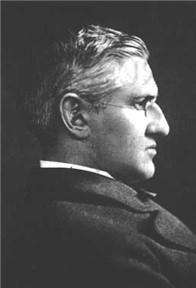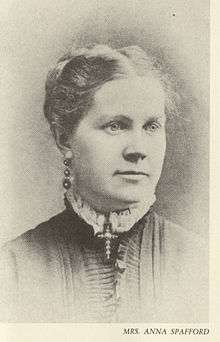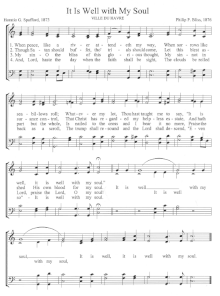Horatio Spafford
Horatio Gates Spafford (October 20, 1828, Troy, New York – October 16, 1888, Jerusalem)[1] was a prominent American lawyer and Presbyterian church elder. He is best known for penning the Christian hymn It Is Well With My Soul following a family tragedy in which his four daughters died aboard the S.S. Ville du Havre on a transatlantic voyage.

Life

Spafford was the son of Gazetteer author Horatio Gates Spafford and Elizabeth Clark Hewitt Spafford.
On September 5, 1861 he married Anna Larsen of Stavanger, Norway in Chicago. Spafford was a lawyer and a senior partner in a large law firm.[2] The Spaffords were supporters and friends of evangelist Dwight L. Moody.[3]
Spafford invested in real estate north of Chicago in the spring of 1871. In October 1871, the Great Fire of Chicago reduced the city to ashes, destroying most of Spafford's investment.[3]
The wreck of the Ville du Havre
Two years after the devastation of the Great Chicago Fire the family planned a trip to Europe. Late business demands (zoning issues arising from the Fire) kept Spafford from joining his wife and four daughters on a family vacation in England where his friend D. L. Moody would be preaching.
On November 22, 1873, while crossing the Atlantic on the steamship Ville du Havre, the ship was struck by an iron sailing vessel[4] killing 226 people, including all of Spafford's daughters. His wife, Anna, survived the tragedy. Upon arriving in England, she sent a telegram to Spafford that read "Saved alone."[5] As Spafford sailed to England to join his wife, he wrote "It Is Well with My Soul."
It Is Well with My Soul lyrics

The original manuscript[6] has only four verses, but Spafford's daughter, Bertha Spafford Vester, who was born after the tragedy, said an additional verse was later added and the last line of the original song was modified.[7] The music, written by Philip Bliss, was named after the ship on which Spafford's daughters died, Ville du Havre.
When peace, like a river, attendeth my way,
When sorrows like sea billows roll;
Whatever my lot, Thou hast taught me to say,
It is well, it is well with my soul.
(Refrain:) It is well (it is well),
with my soul (with my soul),
It is well, it is well with my soul.
Though Satan should buffet, though trials should come,
Let this blest assurance control,
That Christ hath regarded my helpless estate,
And hath shed His own blood for my soul.
(Refrain)
My sin, oh the bliss of this glorious thought!
My sin, not in part but the whole,
Is nailed to His cross, and I bear it no more,
Praise the Lord, praise the Lord, O my soul!
(Refrain)
For me, be it Christ, be it Christ hence to live:
If Jordan above me shall roll,
No pain shall be mine, for in death as in life
Thou wilt whisper Thy peace to my soul.
(Refrain)
And Lord haste the day, when the faith shall be sight,
The clouds be rolled back as a scroll;
The trump shall resound, and the Lord shall descend,
Even so, it is well with my soul.
(Refrain)
Later years
Following the sinking of the Ville du Havre, Anna gave birth to three children, Horatio Goertner, (1877), Bertha Hedges (March 24, 1878) and Grace (January 18, 1881).[3] On February 11, 1880, Horatio died of scarlet fever at age three.[8] This final tragedy, after a decade of financial loss and personal grief accompanied by a lack of support from their church community, began Horatio's philosophical move away from material success towards a lifelong spiritual pilgrimage. Anna and Horatio Spafford soon left the Presbyterian congregation Horatio had helped build and hosted prayer meetings in their home.[9] Their Messianic sect was dubbed "the Overcomers" by the American press.[10]
In August 1881, the Spaffords went to Jerusalem as a party of 13 adults and three children to set up an American Colony. Colony members, joined by Swedish Christians, engaged in philanthropic work among the people of Jerusalem regardless of their religious affiliation and without proselytizing motives, gaining the trust of the local Muslim, Jewish and Christian communities.
In Jerusalem, Horatio and Anna Spafford adopted a teenager, Jacob Eliahu (1864–1932), who was born in Ramallah into a Turkish Jewish family. As a schoolboy, Jacob Spafford discovered the Siloam inscription.[11][12]
Death
Spafford died of malaria on October 16, 1888 and was buried in Mount Zion Cemetery in Jerusalem.
Legacy
During and after World War I, the American Colony supported the Muslim, Jewish, and Christian communities of Jerusalem at the Eastern front and during the Armenian and Assyrian Genocides by hosting soup kitchens, hospitals, and orphanages.[13]
References
- "Source of middle name and birth/death information".
- https://www.loc.gov/exhibits/americancolony/images/ac0004bs.jpg
- Spafford, Horatio; Spafford, Anna; Ives, Currier & (January 12, 2005). "Family Tragedy - The American Colony in Jerusalem | Exhibitions - Library of Congress". www.loc.gov.
- https://www.loc.gov/exhibits/americancolony/images/ac0005s.jpg
- https://www.loc.gov/exhibits/americancolony/images/ac0006s.jpg
- "Photo of manuscript".
- Bertha's history Archived 2006-04-27 at the Wayback Machine. Bertha Spafford Vester. (1988). Our Jerusalem: An American Family in the Holy City, 1881-1949. Jerusalem: American Colony, 364 pp., ISBN 0-405-10296-8.
- Hancock, Sandy (2008). Letting Go: Pathway to an Amazing Life. iUniverse. p. 11. ISBN 978-0-595-48624-3.
- "Saved Alone | A Community in Jerusalem | Articles and Essays | American Colony in Jerusalem, 1870-2006 | Digital Collections | Library of Congress". Library of Congress, Washington, D.C. 20540 USA.
- Jerusalem: The Biography, page 365, Simon Sebag Montefiore, Weidenfeld & Nicolson, 2011. ISBN 978-0-297-85265-0
- Mission, Our. "How Strange Does the American Colony Story Get? Meet the Founders' adopted Jewish son, responsible for one of the most incredible archeological finds in Jerusalem in 130 years".
- "Jacob Eliahu Spafford (1864-1932) - Find A Grave..." www.findagrave.com.
- Library of Congress Exhibition Overview. See also Yaakov Ariel & Ruth Kark. (1996, December). "Messianism, Holiness, Charisma, and Community: The American-Swedish Colony in Jerusalem, 1881-1933," Church History, 65(4), 641-657.
External links
![]()
- SpaffordHymn.com : The original Hymn manuscript penned by Horatio Spafford
- Cyber Hymnal Photos of Horatio Spafford and a MIDI file of the hymn
- Elisabeth Elliot recalls tea with Horatio Spafford's daughter
- Gospelcom.net
- Christianity.ca Many details on life of Spafford
- The Library of Congress Exhibition covering the start of The American Colony in Jerusalem, the Spafford Family tragedy, their move to Jerusalem, their time in the Holy Land, and the American Colony at work
- Works by or about Horatio Spafford at Internet Archive
- Works by Horatio Spafford at LibriVox (public domain audiobooks)
